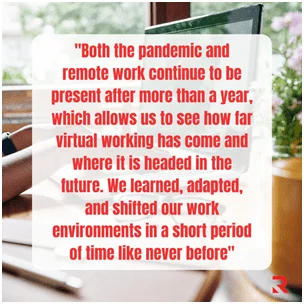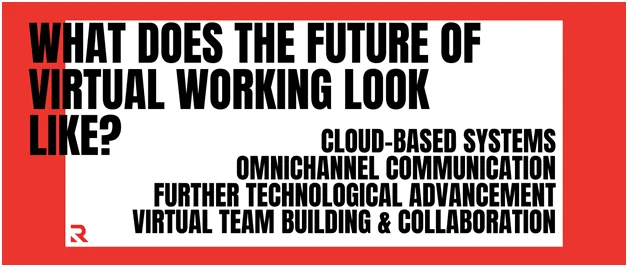Virtual working is not an entirely new phenomenon, but it has made significant strides in recent years. The Covid-19 pandemic has forced businesses and organizations in all industries to turn to remote work to keep employees safe and healthy.
Both the pandemic and remote work continue to be present after more than a year, which allows us to see how far virtual working has come and where it is headed in the future. We learned, adapted, and shifted our work environments in a short period like never before.
One of the most significant impacts of Covid-19 has been the de-stigmatization of virtual working or working remotely. Before the pandemic, leaders were understandably hesitant to encourage their employees to work from home because it was widely believed to lead to lower productivity levels, longer turnaround time, and communication gaps.
However, when the pandemic made working from home a necessity rather than a luxury, everything changed. Here are some of the main things that we have learned about how far virtual working has come and where it is headed:
- Employees Should Be Trusted – One of the key takeaways of how far virtual working has come and where it is headed is that companies need to trust their employees. Creating a strong sense of trust with your team will foster a positive, productive work environment where employees will feel motivated to get their work done remotely.
- Collaboration Is Possible Without An Office – Before the pandemic hit, many employers were hesitant to allow their employees to work from home because communication and collaboration were more complex. However, when virtual working became necessary, companies realized the partnership could be great with the right platforms.
- Productivity Can Thrive Remotely – Another one of the main reasons why companies were reluctant to allow for remote work is because of the assumption that productivity would suffer. However, Covid-19 has shown us firsthand that the future of virtual working can be just as productive, if not more, than working in an office setting.
- Micro-Management Does Not Work – Micromanagement is never a good model for positive and effective leadership, and virtual working has illustrated this. Micro-managing employees cannot be supported with remote work, which means leaders must create trusting, encouraging, and collaborative relationships with their team members.
- Digital Adoption Is Crucial – The future of virtual working is fundamentally dependent on digital platforms. Digital platforms must operate accurately, be user-friendly, and maximize efficiency. Fortunately, the impact of Covid-19 on digital transformation has been positive, as almost all companies and businesses have embraced digital adoption.
These are some of the main lessons that pandemic-driven remote work has taught us thus far. Embracing these lessons, learning from trial and error, and adjusting accordingly will help us create success for the future of virtual working.

What Does The Future Of Virtual Working Look Like?
No one could have anticipated how far virtual working has come and where it is headed in the future. Covid-19 has directly shaped the future of virtual working, and its impact will last for the foreseeable future. Here are some of the trends in remote working:
- Further Technological Advancement – Technology has advanced at a rapid pace as a direct result of Covid-19. As a result, companies of all sizes needed to ramp up their technology to accommodate virtual working, which is expected to continue to improve.
- Cloud-Based Systems – Cloud-based systems are a great asset and resource for working remotely. The future of virtual working will focus heavily on cloud-based systems so that employees and team members can access the right platforms, software, and data to get their job done from anywhere as long as they have an internet connection.
- Omnichannel Communication – Omnichannel communication has also been on the rise recently, as it puts all aspects of communication into one seamless experience. This makes it easier for customers, clients, leaders, and employees to interact with your system without any confusion.
- Virtual Team Building & Collaboration – Connecting with others without being together in person has been one of the biggest challenges to navigate throughout the pandemic. However, companies that utilize virtual team-building exercises claim that their teams are more connected than ever before.

The Impact Of Covid-19 On Digital Transformation
In addition to impacting how far virtual working has come and where it is headed, Covid-19 has also directly and positively impacted digital transformation. Although the circumstances that drove digital transformation were less than desirable, the impact of Covid-19 on digital transformation has been tremendous.
Technology experts claim that the advancements from the past year alone represent over 10 years of growth and improvement. Listed below are some of the aspects of the impact of Covid-19 on digital transformation that speak to the trends in remote working that are to come:
- Investing In IT – Information technology investment priorities have shifted as a result of the pandemic. The impact of Covid-19 on digital transformation has caused organizations to make more targeted investments in IT in areas like cloud infrastructure, connectivity technology, and more.
- Connectivity Needs – The future of virtual working suggests that connectivity is everything. Team members need to be able to connect to the network, cloud, and other platforms at all times to get their work done. Because of this, one of the main trends in remote working includes increasing bandwidth support and using business-grade Wi-Fi.
- Cyber Security Improvements – Cybersecurity concerns have been a massive issue for larger-scale companies to deal with. As their employees work from home with their own network or technology, one of the most crucial trends in remote working is improved cybersecurity systems to fight against increasingly popular malware threats and breaches.
- Network Strengthening – Before the pandemic, employees would connect to their network from one centralized building or office space. However, as people are working from home, these individuals still need to access the network. Consequently, one of the trends in remote working is network strengthening and resilience.
- Customer Service On Digital Platforms – Customer service began to shift to digital platforms before the pandemic. Still, the impact of Covid-19 on digital transformation has caused customer service to work better than ever before on these platforms. In 2021, almost 60% of customer service interactions take place on digital platforms.
- Managed Services Operating Model – A managed services operating model helps manage all digital tools and infrastructure. While many businesses were considering shifting to a managed services operating model before the pandemic, one of the trends for remote work in 2021 is a surge in companies opting to utilize managed services.
The trends in remote working listed above directly resulted from the impact of Covid-19 on digital transformation. Virtual working is far from over, which means that we can expect these trends to continue.
About Us – Rely Services
Rely Services is a leading outsourcing provider that specializes in business process outsourcing. Our BPO services are strategically designed to help our clients excel, grow, and succeed. We serve businesses and companies in various industries with our unparalleled expertise and technology.
Since the pandemic's start, we have analyzed and studied how far virtual working has come and where it is headed in the future. If you want to learn more about the future of virtual working or digital transformation going forward, please Contact Us Here today!
Leave A Reply